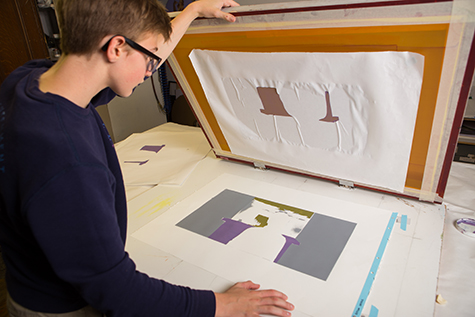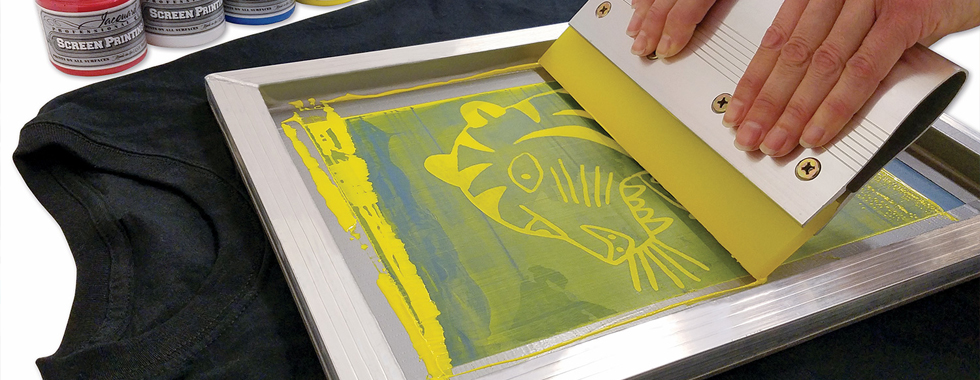Discover the Numerous Kinds of Screen Printing Techniques for Your Next Task
Screen printing provides a varied variety of strategies that can improve any kind of imaginative task. From standard approaches like serigraphy to contemporary developments such as direct-to-garment printing, each strategy has its one-of-a-kind advantages. Specialty choices, consisting of environmentally friendly and metal inks, present even a lot more opportunities. Recognizing these methods can considerably influence the final result. Nonetheless, the challenge hinges on picking one of the most appropriate technique for details needs and wanted results. What aspects should one take into consideration?

The Basics of Screen Printing
Screen printing might appear facility, it is essentially a straightforward procedure that involves transferring ink with a mesh screen onto numerous surface areas. The strategy begins with the creation of a pattern, which specifies the design to be printed. This pattern is connected to a mesh screen, normally made from polyester or nylon. When the stencil is in place, ink is put on the screen and pressed with the mesh making use of a squeegee, causing the desired pattern being printed on the underlying product.
Screen printing can be performed on a variety of substrates, including material, plastic, and paper, making it a functional selection for different jobs. The process enables for dynamic shades and detailed designs, making it popular in industries such as advertising, art, and fashion. Recognizing these essentials outfits people with the foundational expertise required to explore more sophisticated strategies in screen printing.
Conventional Screen Printing Techniques
Standard screen printing methods have actually been utilized for centuries, preserving the workmanship and artistry of this technique. This approach utilizes a mesh screen to transfer ink onto a substrate, such as textile or paper, enabling for vivid and lasting layouts. The process begins with developing a stencil, which obstructs particular locations of the screen to regulate where the ink will be applied.
One popular method is serigraphy, commonly used for limited versions and creative prints. Another is the usage of water-based inks, which are eco-friendly and provide a soft feel on fabrics - 10:9 Design Texas. In addition, typical techniques can include hands-on printing, where artisans apply ink with a squeegee, making certain accuracy and interest to detail
These strategies continue to be valued in the sector for their responsive top quality and the distinct textures they produce, interesting both customers and creators that value the heritage of screen printing.
Digital Screen Printing Innovations
As the demand for faster manufacturing and personalization in the printing industry has surged, digital screen printing innovations have become a game-changer. This innovation blends standard screen printing approaches with electronic processes, enabling quick prototyping and elaborate layouts that were formerly difficult to accomplish. One significant development is the introduction of direct-to-garment (DTG) printing, which assists in premium, full-color prints on various textiles without the demand for displays. In addition, innovations in ink formulations have caused environment-friendly choices that maintain lively colors while minimizing ecological influence. Using automated systems even more streamlines production, minimizing labor expenses and improving accuracy. These innovations not only cater to tiny set orders and tailored styles however likewise permit quicker turn-around times, making them optimal for services concentrated on conference customer demands in a hectic market. Digital screen printing, subsequently, stands for a necessary development in the domain of printing methods.
Specialized Screen Printing Approaches
Checking out specialized screen printing techniques reveals a varied selection of techniques that push the borders of imagination and capability in the printing sector. Among these, glow-in-the-dark inks provide a special aesthetic effect, making layouts come to life in low-light conditions. Metal inks, known for their shimmering surface, add a touch of high-end to published products. One more innovative technique is discharge printing, which eliminates color from the material rather than adding ink, leading to a soft, classic feel. High-density printing produces a raised appearance externally, enhancing tactile engagement. Furthermore, water-based inks are obtaining popularity for their lively shades and lowered environmental impact. Each of these specialized methods caters to specific style demands, making it possible for musicians and brand names to develop standout products that reverberate with their audiences. By leveraging these approaches, services can elevate their screen printing jobs to brand-new elevations, making certain unforgettable perceptions.
Eco-Friendly Screen Printing Options
Green screen printing choices are obtaining traction as the market shifts towards sustainability. Sustainable ink options and the usage of biodegradable products are crucial components in lowering the environmental effect of the printing process. By adopting these practices, screen printers can add to a more lasting future while keeping high-quality outcomes.
Lasting Ink Selections

Biodegradable Products Usage
As the screen printing market advances, the incorporation of naturally degradable products is becoming progressively essential for ecologically conscious techniques. Designers and makers are currently discovering inks and substrates made from all-natural, renewable energies that decompose more efficiently than conventional counterparts. These eco-friendly choices reduce plastic waste and reduce environmental impact, aligning with the expanding demand for lasting items.
Common instances consist of water-based inks and organic cotton fabrics, both of which reduce dangerous chemicals and advertise eco-friendliness. Brands that adopt these products often boost their market allure, bring in customers that prioritize here sustainability. As recognition of ecological issues remains to rise, the shift towards biodegradable products in screen printing is likely to obtain momentum, cultivating a greener industry requirement.
Selecting the Right Method for Your Job
Just how can one figure out the most ideal screen printing technique for a specific job? The decision hinges on numerous variables, including the product to be printed on, the intricacy of the design, and the preferred production quantity - 10:9 Design contact. Direct-to-garment printing is optimal for detailed layouts with many colors, while standard screen printing succeeds for larger runs of less complex graphics.
Additionally, consideration of the end-use of the published thing is crucial. For outdoor applications, techniques that use durability and weather condition resistance, such as plastisol ink, might be preferred. Alternatively, environmentally-conscious projects may profit from water-based inks or eco-friendly products.
Inevitably, understanding the project's one-of-a-kind demands allows for an educated option, making sure both visual appeal and practical durability. By examining style complexity, material compatibility, and manufacturing scale, one can effectively choose one of the most suitable screen printing method to satisfy their project's goals.
Frequently Asked Inquiries
What Is the Background of Screen Printing?
Screen printing came from in old China around 1000 AD, progressing with Japan and Europe. By the 20th century, it ended up being prominent in business art and fashion, revolutionizing just how designs were produced and distributed internationally.

Exactly how Do I Prepare Art Work for Screen Printing?
To prepare art work for screen printing, one should guarantee high resolution, use a suitable color setting, develop different layers for every shade, and convert message to details, ensuring compatibility with the printing procedure and desired end result.
What Materials Are Ideal for Screen Printing?
The best products for screen printing consist of top quality inks, durable screens, and ideal substratums like cotton, polyester, or blends. Furthermore, making use of ideal emulsion and squeegees can improve the printing process and outcomes.
Can I Evaluate Print in your home?
Yes, screen printing at home is possible. With the appropriate products, arrangement, and strategies, people can create high-quality prints. Nonetheless, mindful factor to consider of work area and tools is crucial for effective results.

What Are Typical Errors in Screen Printing?
Typical blunders in screen printing consist of incorrect direct exposure times, insufficient ink uniformity, imbalance of displays, not enough cleaning of materials, and disregarding to test prints. These mistakes can endanger the high quality and accuracy of the end product.
Screen printing might appear complicated, it is basically a simple process that entails moving ink via a mesh screen onto numerous surface areas. As the need for faster production and modification in the printing industry has actually surged, electronic screen printing innovations have emerged as a game-changer. Exploring specialized screen printing methods exposes a diverse selection of techniques that press the limits of creativity and functionality in the printing sector. The best materials for screen printing consist of high-quality inks, durable displays, and appropriate substratums like cotton, polyester, or blends (10:9 Design Abilene). Usual mistakes in screen printing consist of inappropriate exposure times, poor ink uniformity, misalignment of screens, inadequate cleansing of products, and disregarding to test prints